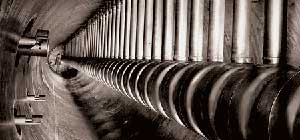The Great Burrito Tunnel
Do you live on the East Coast?
Do you eat Burritos?
Ever wonder where they came from?
Check out:
The Alameda-Weehawken Burrito Tunnel

Who can imagine New York City without the Mission burrito? Like the Yankees, the Brooklyn Bridge or the bagel, the oversize burritos have become a New York institution. And yet it wasn’t long ago that it was impossible to find a good burrito of any kind in the city. As the 30th anniversary of the Alameda-Weehawken burrito tunnel approaches, it’s worth taking a look at the remarkable sequence of events that takes place between the time we click “deliver” on the burrito.nyc.us.gov website and the moment that our hot El Farolito burrito arrives in the lunchroom with its satisfying pneumatic hiss.
The story begins in any of the three dozen taquerias supplying the Bay Area Feeder Network, an expansive spiderweb of tubes running through San Francisco’s Mission district as far south as the “Burrito Bordeaux” region of Palo Alto and Mountain View. Electronic displays in each taqueria light up in real time with orders placed on the East Coast, and within minutes a fresh burrito has been assembled, rolled in foil, marked and dropped down one of the small vertical tubes that rise like organ pipes in restaurant kitchens throughout the city.
Once in the tubes, it’s a quick dash for the burritos across San Francisco Bay. Propelled by powerful bursts of compressed air, the burritos speed along the same tunnel as the BART commuter train, whose passengers remain oblivious to the hundreds of delicious cylinders whizzing along overhead. Within twelve minutes, even the remotest burrito has arrived at its final destination, the Alameda Transfer Station, where it will be prepared for its transcontinental journey.
Ever since Isaac Newton first described the laws of gravity in 1687, scientists have known that the quickest route between two points is along a straight line through the Earth’s interior. Through the magic of gravity, any object dropped into such a “chord tunnel” at one end will emerge exactly 42 minutes later at the other end, no matter the distance. But for hundreds of years, the technical challenges of building such a tunnel were so daunting that it remained a theoretical curiosity. Only at the start of the 20th century did the idea become technically feasible, and to this day the tunnel linking the East Bay with New Jersey remains the only structure of its kind in the world.
From the outside, the Alameda facility looks like any other industrial building. Behind a chain link razor wire fence sits a windowless white hangar some three stories tall, surrounded by a strip of green lawn. If you could see underground, however, you’d see that the building sits at the center of a converging nexus of burrito pipes. High pressure pneumatic tubes from all over the Bay Area emerge in the center of the facility, spilling silvery burritos onto a high-speed sorting line. The metal-jacketed burritos look like oversize bullets, and the conveyor belts that move them through the facility resemble giant belts of delicious ammunition. Within a few seconds of arrival the burritos have been bar coded, checked for balance and round on a precision lathe, and then flash-frozen with liquid nitrogen.
The mouth of the tunnel is a small concrete arch in the side of a nearby hill, about as glamorous as an abandoned railway tunnel. Yet if you could open the airlocks and stare down its length with a telescope, you would see airplanes on final approach to Newark Airport, three thousand miles away! To reduce drag on the burritos to a minimum, the tunnel must be kept in near-vacuum with powerful pumps. At the tunnel’s deepest point the burritos will be traveling nearly two kilometers a second - even the faintest whiff of air would quickly drag them to a stop.
The launch tube for the burritos lies just under the tunnel mouth and looks like what it is: an enormous gun. Every four seconds a ‘slug’ of ten burritos, white with frost, ratchets into the breech. A moment later it flies into the tunnel with a loud hiss of compressed gas, and the lights dim briefly as banks of powerful electromagnets accelerate the burritos to over two hundred miles an hour. By the time they pass Stockton three minutes later the burritos will be traveling faster than the Concorde, floating on an invisible magnetic cushion as they plunge into the lithosphere.
I had no idea... Much more at the website.
Posted by DaveH at April 8, 2007 12:22 PM
